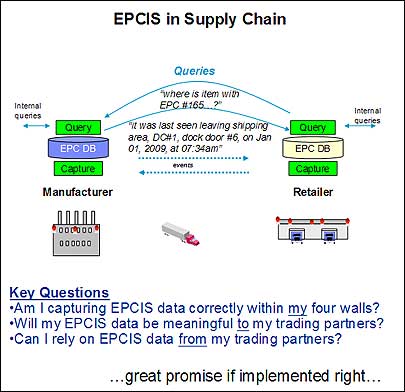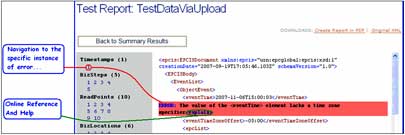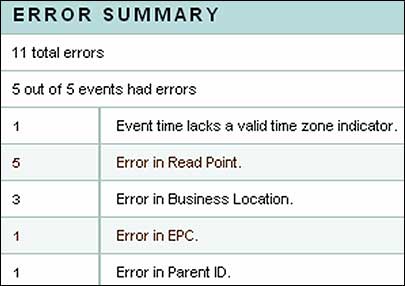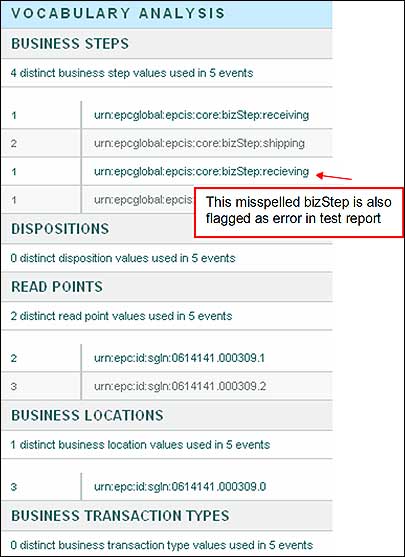> Osinski
Feb. 23, 2009—EPC Information Service (EPCIS), one of the most important standards developed by EPCglobal, defines an EPCIS event, which contains information regarding a product tagged with an EPC Gen 2 passive RFID chip, as well as rules for exchanging event data. For instance, a typical event may contain a list of Electronic Product Codes (EPCs) for each tagged box on a pallet leaving a manufacturer’s shipping area en route to a retailer. Other data, such as the date and time the box readings were performed, the location of the read (dock door #6, for example), temperature or an associated purchase order can also be stored as part of the event. In essence, the event contains information about the “what, when, where and why” of the tagged product.
A manufacturer can send an event to a retailer as a truck leaves its premises. A retailer would then know the quantity of boxes to expect upon receiving the shipment. When a box reaches the retailer’s sales floor, another event could be generated and sent back to the manufacturer, thus enabling the latter to know how long it took for a product to reach the sales floor, and how quickly it was sold.
An event is composed of four elements: structure, common business vocabulary (CBV), queries and communication protocol. Structure is an XML schema that defines rules for creating an event and custom extensions. Common business vocabulary (CBV) is terminology that defines business data pertaining to a physical object. An example of CBV is business_step “shipping” or business_transaction “po” (for purchase order). Queries are governed by a rules-based mechanism for formulating questions and delivering results (see Fig. 1 for an example of a query). The communication protocol—the method employed to exchange EPCIS events—may be any of several Internet-based protocols, such as HTTP, HTTPS or AS2.
Deployment of EPCIS offers many technical and business advantages, including:
• Data sharing and supply chain visibility: EPCIS event data can originate from various sources (for example, tags, RFID reader middleware, ERP software, an WMS and trading partners). This information (accessed via queries) is instantly available within a company’s facilities, or can be shared with its trading partners. This is valuable for tracking tagged items.
• Monitoring day-to-day RFID applications: Events can expose problems that may have occurred within a company’s own operations, or elsewhere. Invalid data—such as an incorrectly encoded EPC number on a tag, missing business steps or a non-standard XML extension—could limit the benefits of an RFID application.
• Data mining: EPCIS repositories will store thousands of events. The event data can help companies calculate the effectiveness of RFID-enabled business processes, or assess an entire RFID implementation at the enterprise level.
EPCIS has the potential to enhance entire supply chains by providing real-time visibility of the tagged items inside an enterprise and between trading partners (see Fig 1). Leading retailers and suppliers, such as Wal-Mart, Procter & Gamble (P&G) and Metro, are already capturing and exchanging EPCIS data.
There are three steps that companies can take to realize the full potential of EPCIS:
1. Minimize interoperability issues. This can be achieved by purchasing EPCglobal-certified hardware and software, and by ensuring that the EPC is encoded correctly on the tag.
2. Maximize the quality of EPCIS data. Businesses should thoroughly test their event data before going live with an EPCIS application. Incorrectly encoded EPC numbers, invalid vocabulary data and missing event fields and other errors should be recognized and corrected. A company should also request that trading partners validate their data before sending it. Validation of EPCIS event data should be an ongoing task, in fact.
3. Assess RFID implementations. EPCIS repositories can provide a wealth of analytical and statistical data, such as which business processes and transactions have been RFID-enabled, or which locations create the most events.
If you remember the early bar-code days, then you realize that services and tools to ensure the quality of the scan and correct data encoding were missing for years, which slowed down the adoption of bar codes. Luckily, help—in the form of an online service known as the EPCIS Validation Portal—already exists for businesses implementing radio frequency identification.
EPCIS Validation Portal
The EPCIS Validation Portal (EPCIS VP) is a self-testing service available to end users via the Internet. It is offered by GS1 member organizations with support from EPCglobal and MET Laboratories, which developed and manages the EPCglobal Hardware Certification Program (HCP) and the Global Performance Test Center Accreditation Program.
EPCIS VP analyzes a user’s EPCIS data and verifies an implementation’s adherence to the EPCIS specification, EPC tag data standards and EPCIS common business vocabulary. In addition, EPCIS VP produces analytical reports, including an error summary, events analysis (for example, the number of read portals and their locations, business steps or business transactions used, the number of EPC keys read and the types of EPC keys used).
EPCIS VP Benefits
Using the EPCIS VP service, companies can identify and eliminate data errors, thereby expediting the implementation and deployment of EPCIS, and maximizing the sharing of EPCIS information between trading partners.
How Does EPCIS VP Work?
Users can log on to the EPCIS VP server at the EPCIS Web site and upload an XML file containing EPCIS data. Another option for users is to push information from their EPCIS server directly to the EPCIS VP server.
The system analyzes input data and checks for 68 types of errors on all four types of events (Object, Aggregation, Transaction and Quantity). The errors are presented in a user-friendly manner, with on-line help available. The system is intuitive, and expertise is not required to understand the errors or suggestions for correcting them. The system marks and annotates user EPCIS data (see Fig 2).
To view a larger version of this image, click here.
The event errors are summarized as follows:
Analysis of EPCIS Events
Besides looking for errors, the system provides a summary analysis of the input data, including the types of EPCIS events utilized, the vocabulary (as specified by EPCglobal standards workgroups), locations, EPCs and extension fields. This information is quite valuable even if the EPCIS data contains no errors (an unlikely scenario in the current phase of RFID adoption). An example of vocabulary analysis is provided below.
Developed by Experts and Users
EPCIS VP was developed as a collaboration between EPCglobal, MET Lab, Ken Traub Consulting and RFID software provider Korgi. Metro, Wal-Mart, P&G and IBM participated in extensive beta-testing that included functionality and performance testing.
Companies that have already invested in radio frequency identification must begin thinking about leveraging EPCIS to achieve the maximum benefits from this technology. Standards, certified hardware and software, and other supporting services, such as EPCIS VP, are there to help. EPCIS is ready to take off.
Ted Osinski is the director of RFID programs at MET Laboratories, which provides testing certification services for a range of standards, including RFID.






